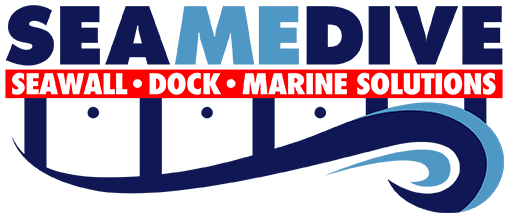Sea Me Dive inspectors are often called upon when there is a transaction, meaning the selling or purchasing of a waterfront property, and the Seawall inspection is part of the Sale process. Other times an owner will reach out when they notice something is not quite right with their seawall such as visible signs of cracks or corrosion and they require our seawall construction expertise in the matter.
Every year, Sea Me Dive, helps hundreds of clients make important decisions about their seawalls.
We always recommend an inspection to determine the state and current condition of the Seawall. When was it constructed? What materials were used? What are the visible issues? Is the Seawall position straight? Does it show signs of leaning forward or separation? What is the seawall height? Is it current with the latest municipal requirements?
Our commercial divers will ALWAYS dive in and check below tide level since most seawall structures are 50%-60% underwater.
Our divers check the foundation and base of the Seawall and confirm the existence (or not) of the toe wall footer, as well as soil composition and the underwater conditions of the Seawall. Are there any voids? Does the wall have any cracks? And if so, are they hairline cracks or extensive separation cracks? Are there any signs of corrosion?
The frequent heavy rains and flooding in South Florida result in intense hydrostatic pressure from the upland side on the seawall. Does the Seawall have a way to release this pressure and reduce the impact on the Seawall? Another important observation will be checking the neighbors; how is the condition of their Seawall? Is it higher or lower than yours? What effect is it having on your own seawall?
We take pictures and videos and show the homeowners precisely what we see. We write a detailed report and are always available to discuss our findings.
After a thorough inspection, our construction team will analyze the data and observations and determine the best course of action. Sometimes the seawall structure can be repaired, other times we must recommend replacing the Seawall altogether.
If our team determines that there is nothing to restore or save and that the condition of the Seawall is terminal, compromised beyond repair, a new seawall construction is the only option. In many other cases, our team will recommend Seawall restoration and repairs, saving tens of thousands of dollars for homeowners, condos, and commercial real estate groups.
Using innovative techniques and materials to reconstruct the Seawall, we can raise the caps, bring the Seawall to the required NAVD level, fix the cracks, and install tie-backs to strengthen the wall. We use noncorrosive mesh to support the structure and make the Seawall stand strong and proud, prolonging the life of the Seawall for many years to come.
In one recent seawall construction project for a private property in Fort Lauderdale, we recommended the restoration of the Seawall and the repair of hairline and separation cracks in the seawall panels and cap areas.
The identified areas were first marked and then chipped to expose the entire length of damage prior to treatment. Seawall areas that showed extensive corrosion in the rebars were treated with a rust converter in each section to help eliminate the spread of corrosion, followed by our team filling in the cracks with 6000-7000 PSI non-shrink Hydraulic concrete grout. For aesthetic reasons, the seawall wall cap can be painted when the repair work is complete.
Our best advice when you consider whether to construct a new seawall or to repair your seawall will be to take the time to do a detailed seawall inspection. Many issues can only be revealed when you dive into the water and see the true conditions below the tide level.
